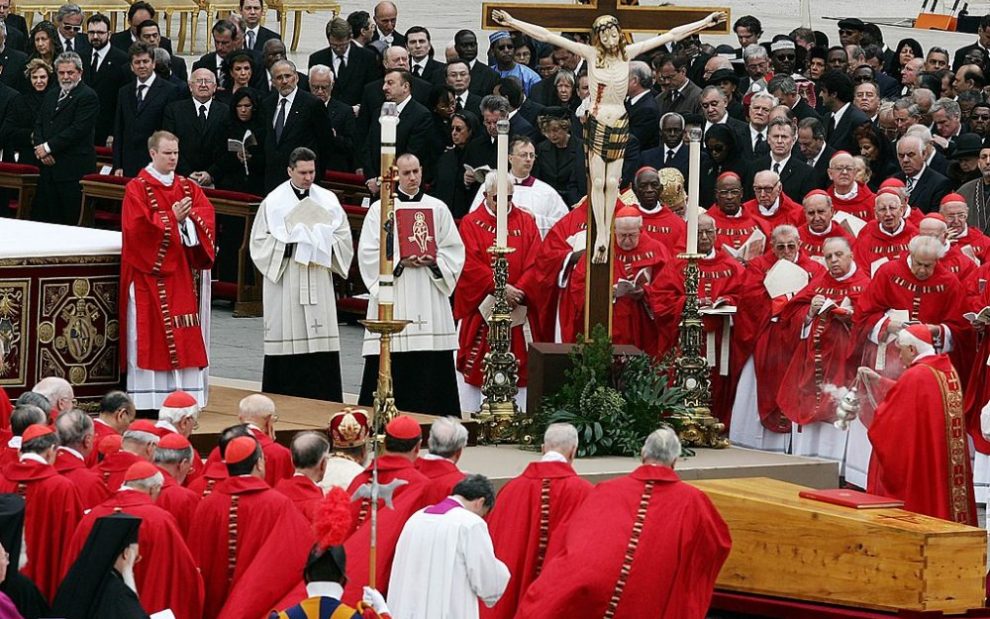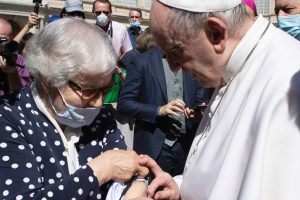It’s been more than a decade and a half since Catholics around the world converged on St. Peter’s Square in Vatican City for the solemn funeral Mass of St. Pope John Paul II, a beautiful event that turned out to be the pope’s final lesson to the church on the high art of liturgical prayer. With no immediate props but his own coffined body, he delivered the final soliloquy of his papacy, a wordless sermon on the importance of remaining steadfast in one’s commitment to a life of prayer.
The final details of the scene had been choreographed months in advance, its basic form built up over centuries by the deaths of other popes. Countless viewers, perhaps thinking themselves cheated for having to rely on TV coverage of the service, were instead treated to sweeping, panoramic views of Vatican Hill and close-ups of ceremonial details that even those dignitaries assigned the choicest seats couldn’t have enjoyed. It was as if the bishops of the Second Vatican Council, in their efforts a half century earlier to give the church a good “airing out,” really had succeeded in throwing open the church’s doors and windows.
St. Pope John Paul II may have wanted it that way, having never been one in life to confuse the inherent mysteries of the faith with the means adopted by the church for veiling its rites from public view. Through his death, the former actor-turned-pope with a knack for stagecraft called a vast ecumenical audience to the doorstep of St. Peter’s Basilica.
Open-air Masses were a familiar part of Karol Wojtyła’s papacy. His historic trips to the world’s great cities always included public celebration of the Eucharist at enormous parks or sports stadiums dressed up to serve as sacred spaces. He attracted to those places great throngs of people eager to hear that their lives mattered and that the world they inhabited was capable of redemption. It wasn’t the amplitude or shock quotient of his message but its basic humanity that St. Pope John Paul II’s listeners found so arresting. “Christianus alter Christus,” he told listeners over countless booming PA systems. “Every Christian is, another Christ. ”
It was this kind of thinking that made him an unwavering advocate for the unborn. It also explains why in 1983 he consented to meet with Mehmet Ali Ağca, the Turkish terrorist and would-be assassin who tried two years earlier to gun him down in St. Peter’s Square. The two men were bound in a Cain-and-Abel blood relationship, the pope later explained. Both were agents in a cosmic struggle between love’s power to call life out of nothingness and fear’s need to annihilate everything in its path. This revelation came to both men during the first of their meetings in an Italian maximum-security facility-turned-confessional, where the pope traded Ağca’s remorse for forgiveness in an extraordinary gesture of reconciliation.
St. Pope John Paul II’s habit of enjoining people to enter with him into God’s transformative presence in places unbound by sanctuary walls was traceable to his earliest days as a priest in Poland. There he’d steal away with groups of young followers into the backwoods and consecrate bread and wine under a canopy of pine boughs and blue sky. Back then, an overturned kayak or stone worked nicely as an altar. On the morning of his funeral, it was the gently sloped Vatican Hill from which he did his final teaching on the subject of sacred worship. In place of the natural settings he’d loved in his youth lay the urban environs of St. Peter’s Square. St. Pope John Paul II’s personal search for sanctity in the concreteness of space and time had come full circle.
On one level, the pope’s funeral was important in the way it seemed to unify for a moment Catholics at opposite sides of the debate over liturgical propriety. St. Pope John Paul II weighed in heavily on the matter during his papacy, arguing that much of the tinkering with liturgy done in the name of Vatican II had debased the worship experience of average Catholics or made it indistinguishable from popular entertainment.
It seemed to unify for a moment Catholics at opposite sides of the debate over liturgical propriety.
Advertisement
Yet he was never a strict rubrician. His fondness for church history never caused him to treat Catholic tradition as frozen or lifeless. While serving as archbishop of Krakow, Poland, he enthusiastically supported the construction of the modern Marian church at Nowa Huta, a large, round-bellied building that countered the dismal landscape dreamed up by the town’s socialist planners. Likewise, in his final years as bishop of Rome, he personally blessed drawings for the city’s newest parish church, the controversial and iconic Dio Padre Misericordioso, or “Jubilee Church,” whose broadly arced sail walls of concrete embody the aspirations of an ecclesial community carried forward by a force no more visible than the wind.
As a witness and lifelong student of Vatican II, St. Pope John Paul II had much to do with helping the church find its place in the modern world. He understood that liturgy, if it is to be authentic at all, must give voice to the faithful in the here and now even while it preserves the church’s ancient habits of self-expression.
Catholics who turned out for the pope’s funeral were there in part to participate in a historical event. Yet no one blinked an eye at the immense jumbotron screens that had been wheeled into the square, modern-day versions of the altarpieces, and reredos carvings of a previous age that made liturgical actions seem real and immediate to assemblies of lay worshippers. Nor did they refrain from chanting, cheering, whistling, clapping, waving banners, ringing handbells, and otherwise carrying on in the most “indecorous” ways as the church’s assembled leadership looked on.
For all its deference to papal custom, this occasion was a distinctly modern farewell party for a pope the people had referred to as “JP II.” This was a pope who, for all his commitment to tradition, was fond of breaking with custom to make a point. He had been the quintessential teaching pope, whose classroom was the world, whose text was Christ crucified, and whose model was Mary, Mother of Grace. Apart from his voluminous scholarly writings, he’d scratched traces of his thoughts on the chalkboard of people’s souls, who took from his funeral a number of important lessons.
Ritual beauty is transformative
If there was a common theme to the on-camera remarks made by non-Catholic observers of the pope’s funeral, it was that the ceremony was stirring—not in some superficial way but deep down, where the mind and spirit confront the finality of earthly life and struggle to release themselves freely to the mystery of death. A Methodist couple from Kentucky who were vacationing in Rome and decided to take in the proceedings told CNN how genuinely moved they were by the solemn poetry of the church’s rites and how they sensed that, in the sanctity of this moment, the denominational boundaries separating Christians were of little consequence. Likewise, President George W. Bush and his wife, Laura, and former First Couples George H. W. and Barbara Bush and Bill and Hillary Clinton—all Protestants—spoke of being profoundly moved by the ceremonies surrounding the pope’s death.
For all its deference to papal custom, this occasion was a distinctly modern farewell party.
The funeral was not merely the end of one man’s earthly journey but the beginning of another for which he’d prepared a lifetime. He’d fought the good fight, finished the race, and kept the faith, as St. Paul, one of his pontifical namesakes, had (2 Tim. 4:7), which made his funeral seem less like a send-off than a victory lap festooned in ritual beauty.
Even Vatican-sized events possess a personal dimension
Although the funeral of St. Pope John Paul II was reputed to be the largest in church history, there was something intimate and personal about its unfolding. Large-scale pageantry, widowiskowość in Polish, may have been something for which Wojtyła had a flair, but so was intymność, the intimacy of those acts that went unseen in Vatican confessionals, at the bedsides of the dying, and in prison cells. Some of this intimacy found amid the grandeur of the day harkened back to the parish outings of his young pastorate.
In a gesture of humility, St. Pope John Paul II asked to have his remains placed deep into the earth beneath St. Peter’s Basilica, not enshrined trophy-like in an aboveground mausoleum. Although his burial niche in the Vatican grottoes would be marble-lined, it put him closer to the humus (ground) from which all humanity takes its start and name.
The interment may have been the quietest part of the day—and the most personal. Removed from the glare of TV cameras and popular commotion aboveground, it was not unlike the burial of any other Christian. Death had reduced the personage of Wojtyła to a person among countless others.
The prayer of the church is the prayer of the world
Strictly speaking, the funeral was a “cultic” affair—an expression of Catholic piety most intelligible to the faithful. However, there was nothing secretive or clandestine about the way even its solemnest aspects were presented to onlookers of other religions. Under a natural canopy of sun and sky, with the world peering in, the church presumed to unveil the greatest of its treasures, the Eucharist.
St. Pope John Paul II exhorted the church to carry Christ’s message into the “field” and “vineyard” when he first began to speak of his “new evangelization.” What his funeral offered the church was an opportunity to harvest both on the grandest scale possible by reversing the evangelization process for three or four hours. Aided by modern telecommunications, it invited the pious and curious alike to look freely upon the very table ritual to which it ascribes salvation.
By most accounts, the hospitality was met with positive response, even from those who harbored misgivings about this pope. A young woman from Bari in the south of Italy, for instance, told the New York Times that she thought St. Pope John Paul II was too rigid on Catholic doctrine and too lax in his response to the AIDS crisis. She traveled to Rome for the funeral, nevertheless, because she regarded him a “good man” and surmised that was why so many others had made their way to the city.
It invited the pious and curious alike to look freely upon the very table ritual to which it ascribes salvation.
Although inclusiveness, as we use the term today, was likely not an explicit goal of the funeral’s planners, proof of St. Pope John Paul II’s wide effect on people lay in the fact that so many chose to be part of this liturgical assembly, even if they should rarely be found in the same space otherwise. “The pope who tried to meet everyone [and] . . . open his heart to all” had given them reason to do so by way of his passing, Cardinal Joseph Ratzinger noted in his homily, along with “all those throughout the world . . . united [for the occasion] through radio and television.”
The bishops who’d processed through the same square decades earlier for Vatican II’s opening ceremonies had famously declared, in Gaudium et Spes (Pastoral Constitution on the Church in the Modern World), “the joys and the hopes, the griefs and the anxieties of the men [and women] of this age” to be those that the church itself embraced. As archbishop of Krakow, Wojtyła had played a hand in crafting such statements and a larger theology of the church that envisioned it as the place where the earthly and heavenly dimensions of people’s lives achieve “penetration.”
These days, when so little agreement can be found in the church on any matter, it’s hard not to look back wistfully on
the events surrounding the burial of St. Pope John Paul II.
The squabbling that persists in Catholic circles on the high art of worship seems less a mark of zeal for sacred liturgy than a kind of zealotry that does little to help the church pray with a single voice.
If, however, the events of April 8, 2005 offered Catholics a glimpse of what unity might look like, then the burial of St. Pope John Paul II may yet be interpreted as seeding the ground for the immortality of the church and its watering through the tears of millions shed in joyful hope and deepest gratitude.
This article also appears in the November 2021 issue of U.S. Catholic (Vol. 86, No. 11, pages 22-26). Click here to subscribe to the magazine.
Image: Ricardo Stuckert/PR, via Wikimedia Commons, [CC BY 3.0 BR]













Add comment